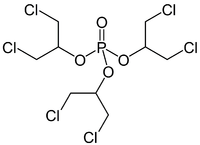Tris (1,3-dichloroisopropyl) phosphate
| Structural formula | ||||||||||||||||
|---|---|---|---|---|---|---|---|---|---|---|---|---|---|---|---|---|

|
||||||||||||||||
| General | ||||||||||||||||
| Surname | Tris (1,3-dichloroisopropyl) phosphate | |||||||||||||||
| other names |
|
|||||||||||||||
| Molecular formula | C 9 H 15 Cl 6 O 4 P | |||||||||||||||
| Brief description |
colorless liquid |
|||||||||||||||
| External identifiers / databases | ||||||||||||||||
|
||||||||||||||||
| properties | ||||||||||||||||
| Molar mass | 430.91 g mol −1 | |||||||||||||||
| Physical state |
liquid |
|||||||||||||||
| density |
1.514 g cm −3 (25 ° C) |
|||||||||||||||
| Melting point |
<−20 ° C |
|||||||||||||||
| boiling point |
326 ° C |
|||||||||||||||
| Vapor pressure |
9 hPa (65 ° C) |
|||||||||||||||
| solubility |
very bad in water (18.1 mg l −1 at 20 ° C) |
|||||||||||||||
| safety instructions | ||||||||||||||||
|
||||||||||||||||
| Toxicological data | ||||||||||||||||
| As far as possible and customary, SI units are used. Unless otherwise noted, the data given apply to standard conditions . | ||||||||||||||||
Tris (1,3-dichloroisopropyl) phosphate ( TDCPP ) is a chemical compound from the phosphoric acid ester group .
properties
TDCPP is a colorless, odorless and viscous liquid. It is heavy in water, but soluble in alcohols , ketones (such as acetone ) and chlorinated hydrocarbons . At temperatures above around 250 ° C, the compound decomposes, releasing phosphorus and carbon oxides and chlorine compounds.
use
TDCPP is used as flame retardants (eg for. Polyurethane foams , polyisocyanurate foams , and styrene - butadiene - rubber compounds ) is used. It is produced for this in an order of magnitude of around 10,000 t per year in the EU.
Safety instructions / toxicology
TDCPP is suspected to have a carcinogenic effect in humans as this has been shown in animal experiments. TDCPP is e.g. B. detectable in carpets and car seats.
Tris (1,3-dichloroisopropyl) phosphate was included by the EU in 2017 in accordance with Regulation (EC) No. 1907/2006 (REACH) as part of substance evaluation in the Community's rolling action plan ( CoRAP ). The effects of the substance on human health and the environment are re-evaluated and, if necessary, follow-up measures are initiated. The reason for the uptake of tris (1,3-dichloroisopropyl) phosphate were concerns about its properties as a potential endocrine disruptor . The reassessment is to be carried out by Germany from 2020 .
See also
Web links
- Federal Environment Agency : Fact Sheet Trisphosphate ( Memento from November 12, 2011 in the Internet Archive ) (PDF; 43 kB)
Individual evidence
- ↑ a b c d e f g TDCPP data sheet at Sigma-Aldrich , accessed on May 14, 2017 ( PDF ).
- ↑ Entry on tris (1,3-dichloroisopropyl) phosphate in the GESTIS substance database of the IFA , accessed on July 23, 2016(JavaScript required) .
- ↑ Entry on Tris [2-chloro-1- (chloromethyl) ethyl] phosphate in the Classification and Labeling Inventory of the European Chemicals Agency (ECHA), accessed on August 1, 2016. Manufacturers or distributors can expand the harmonized classification and labeling .
- ↑ Entry on tris (1,3-dichloroisopropyl) phosphate in the ChemIDplus database of the United States National Library of Medicine (NLM) .
- ↑ Åke Bergman , Andreas Rydén, Robin J. Law, Jacob de Boer, Adrian Covaci, Mehran Alaee, Linda Birnbaum, Myrto Petreas, Martin Rose, Shinichi Sakai, Nele Van den Eede, Ike van der Veen: A novel abbreviation standard for organobromine , organochlorine and organophosphorus flame retardants and some characteristics of the chemicals . In: Environment International . tape 49 , 2012, p. 57–82 , doi : 10.1016 / j.envint.2012.08.003 , PMC 3483428 (free full text).
- ↑ a b c data sheet TDCPP (PDF; 167 kB) from Gischem, accessed on May 29, 2016.
- ↑ Entry on tris (1,3-dichloroisopropyl) phosphate at ChemBlink , accessed on February 25, 2011.
- ↑ SCHER, scientific opinion on the risk assessment report on tris [2-chloro-1- (chloromethyl) ethyl] phosphate (CAS number: 13674-87-8), environmental part, November 29, 2007
- ↑ Pollutants in European carpets: Deutsche Umwelthilfe calls for product responsibility for manufacturers and a ban on hazardous substances. In: dhu.de . October 30, 2018, accessed November 18, 2018 .
- ↑ New commuter concern: Cancerous chemical in car seats . medicalexpress.com, accessed on February 7, 2019.
- ↑ Community rolling action plan ( CoRAP ) of the European Chemicals Agency (ECHA): Tris [2-chloro-1- (chloromethyl) ethyl] phosphate , accessed on March 26, 2019.
